初中英语语法状语从句(精讲)
状语从句知识点详解(初中英语专项复习)14

状语从句知识点详解(初中英语专项复习)状语从句的概念: 用一个句子作状语来修饰动词和形容词,以表明动作发生或状态存在的时间、地点、原因等,这个句子就叫做状语从句。
状语从句的分类:状语从句共分为九大类,包括:时间、地点、原因、条件、让步、目的、结果、方式、比较状语从句。
下面分别讲解:一、时间状语从句概念:用来表示时间的状语从句,由when, while, as, till, until,before, after, since等引导。
由于时间状语从句的引导词所表示的意思并非一致,不同引导词表达不同的时间,它们在句子中对应的时态、语态等也有所不同。
例如:when /while引导的时间状语从句when引导的从句的谓语动词通常是瞬间动词,也可以是延续性动词。
从句动作可与主语动作通常先后发生也可同时发生。
I was writing when my sister came back.( come是瞬间动词,只能用when引导,不能用while)He often wrote me when/while he studied in Shanghai International Studies University.( study 是延续性动词,while可代替when)While my mother was cooking , I was playing chess with dad. (cook是延续性的动词,cook和play同时发生)I like playing chess while my sister likes reading stories.我喜欢下棋,而我姐姐喜欢看小说。
(while表示对比)when和while的区别还有:while引导的时间状语从句多用于进行时态,而when引导的时间状语从句多用于一般时态。
While we were playing games, our headmaster called me .我们正在做游戏的时候,校长叫我了。
初中英语语法——状语从句

状语从句一、考点解读今天我们复习状语从句,英语中状语与中文的状语大致相同,分为时间状语、地点状语、原因状语、目的状语、结果状语、条件状语、方式状语等等。
如果一个主从复合句中的从句是用来表示时间,原因等等时,那就称为状语从句。
在主从复合句中修饰主句中的动词、形容词、副词等的从句叫做状语从句,又由于其功能与副词非常相近,又称做副词性从句。
状语从句一般可分为时间状语从句、地点状语从句、原因状语从句、目的状语从句、结果状语从句、条件状语从句、让步状语从句、比较状语从句和方式状语从句九种。
这节课我们主要复习如下的内容:1.时间状语从句2.地点状语从句3.原因状语从句4.目的状语从句5.结果状语从句6.条件状语从句7.让步状语从句8.比较状语从句9.方式状语从句二、专题梳理(一)时间状语从句在句子中起时间状语作用的句子称为时间状语从句。
时间状语从句可以放在句首、句中和句尾。
常用来引导时间状语从句的引导词有:when 当……时候while 当……时候as 当……时候、一边after 在……之后before 在……之前since 自从ever since 自从once 一……就……whenever 不管什么时候by the time 到……as long as 长达……as soon as 一……就……till/until 直到……1.when,while,as的用法从属连词when,while,as都可用来引导时间状语从句,意为“在……时候”。
但在具体用法上又不尽相同。
(1)这三个连词中,when用得最广,常可代替while与as。
与while相比,when引导的从句动词既可是延续性的,也可是终止性的。
as在这一点上与when相同,while所引导的从句中,动词只能是延续性的。
在初中阶段,我们几乎很少讲as引导时间状语从句。
是因为as在初中阶段是一种供了解性的内容。
e.g.When the fire broke out, all the studentswere sleeping soundly.(终止性的)当火灾发生时,所有的学生正在熟睡中。
2024年人教版中考英语语法课件:状语从句知识点归纳

Wherever my sister visits, she will send me a postcard. =No matter where my sister visits, she will send me a postcard.
as
当.....时, 一边...一边...
强调主从句动作同时进行
I saw the sun as I opened the window.
1、时间状语从句
2、until/ till 引导词: ① until和till意为“直到”,很多时候可以互换,但是用于句首的时候,常用until。 Until you get back, I will sit here.
3、让步状语从句
(表示主句中的某一动作或状态与从句中的某一动作或状态在意义上有部分矛盾。) 1、although/though 引导词: although/though意为“尽管,虽然”,不与but连用,但可用yet/ still. Although/ though he works hard, yet he makes slow porgress.
③ She is such a beautiful girl that everybody loves her.
4、结果状语从句
(结果状语从句表示主句中某一动ห้องสมุดไป่ตู้或状态所产生的结果)
4、so…that… 与 such… that… 互换: 两者都意为“如此......以致于”
so+形容词+a/an+单数可数名词+that从句 人称代=s词uc是h为+a了/a避n+免我形重们容复、词,他+用们单来/数代她可替们数前/名面它词提们到”+等t过h代a的t词从人。句、人事称物代等词名有词人的称词、,单主复要数包以括及“你格、的我变、化他。,她/它、你们、
第10讲状语从句(讲义)中考英语一轮复习(学生版)

►第10讲 状语从句 (讲义)目录一 复习目标 掌握目标及备考方向二 考情分析 2023年中考情态动词考情分析 三网络构建知识点头脑风暴四情态动词考向1. 状语从句的概念和分类2. 掌握时间、原因、条件、目的、结果、让步、比较等状语从句连接词的用法3.提升必考题型归纳五真题感悟 中考情态动词经典考题【复习目标】1.掌握状语从句的概念和分类2.掌握时间、原因、条件、目的、结果、让步、比较等状语从句连接词的用法【考情分析】状语从句做题方法: 1.翻译题干2.把题目中的逻辑关系理顺3.带入连接词一一对比,看谁最合适4.千万别忘了主将从现,主过从过等等时态规则5.多读状语从句培养语感,做题速度也会提升状语从句是历年各省市中考必考知识点。
从考查形式看,一般有单项选择、完形填空、词语运用等。
所占分值通常为2~4分。
另外注意状语从句和定语从句、名词性从句的区别;从命题意图看,侧重考查考生的具体语言环境中使用连词的能力。
【网络构建】一、状语从句概述考向二状语从句的连接词概念:在复合句中作状语的从句叫作状语从句。
状语从句一般修饰主句中的动词、形容词或副词等。
功能:九大状语从句分别表示(时间、条件、原因、地点、目的、结果、方式、让步、比较)等意义。
位置:位置灵活,可用于主句之前或之后。
1.when, while, as引导的时间状语从句2. 比较until和till此两个连词意义相同。
肯定形式表示的意思是"做某事直至某时",动词必须是延续性的。
否定形式表达的意思是"直至某时才做某事"。
动词为延续性或非延续性都可以。
正确使用这两个连词的关键之一就在于判断句中的动词该用肯定式还是否定式。
肯定句:I slept until midnight. 我一直睡到半夜时醒了。
Wait till I call you. 等着我叫你。
(在肯定句中可用before代替。
例如:Let’s get in the wheat before the sun sets.)否定句:She didn’t arrive until 6 o’clock. 她直到6点才到。
状语从句知识点详解(初中英语专项复习)7
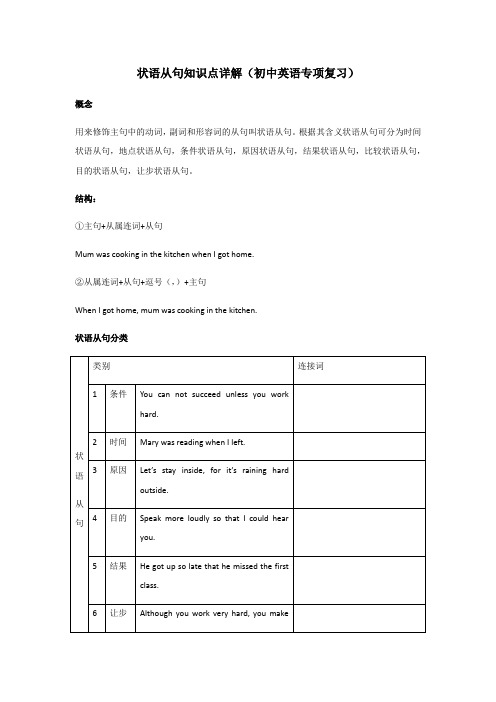
状语从句知识点详解(初中英语专项复习)概念用来修饰主句中的动词,副词和形容词的从句叫状语从句。
根据其含义状语从句可分为时间状语从句,地点状语从句,条件状语从句,原因状语从句,结果状语从句,比较状语从句,目的状语从句,让步状语从句。
结构:①主句+从属连词+从句Mum was cooking in the kitchen when I got home.②从属连词+从句+逗号(,)+主句When I got home, mum was cooking in the kitchen.状语从句分类时间状语从句条件状语从句常见句型转换题:If...not = unless,在句型转换题中,if (如果)常常和unless(除非)and(那么)或or(否则)互换。
If you don’t get up early, you will fail to catch the bus.(保持句意不变)= You won’t catch the bus unless you get up early.=You should get up early, or you will miss the bus.=Get up early, and you may/ will catch the bus.原因状语从句because 和so 不能用于同一句子中,because表示原因未知,语气最强回答why的提问。
because引导的从句可与because of引导的简单句互换。
as 语气最弱,常常用于口语中,since和nowthat(既然)表示已知的原因,一般放在主句之前。
She didn’t go to see the movie because the weather was bad.=She didn’t go to see the movie because of the bad weather.The sports meeting was put off because the weather was bad.=The sports meeting was put off because of the bad weather.目的状语从句so that +从句=in order that+从句常与in order to 和so as to +短语互换,目的状语从句常常会和情态动词can, may, will, could, might, would等连用He walked quickly so that he could get there on time.=He walked quickly in order that he could get there on time.=He walked quickly in order to get there on time.=He walked quickly so as to get there on time.结果状语从句So...that(如此.......以至于)在句型转换中常常会和enough to do 或者too...to互换,结果状语状语从句常常会和情态动词can, may, will, could, might, would等连用。
初中英语语法大全之状语从句专项讲解
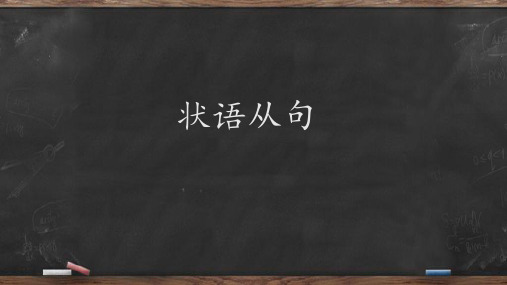
2、地点状语从句
常用引导词:where 例句 Generally, air will be heavily polluted where there are factories.
3、原因状语从句
常用引导词:because, since, as, for 例句 My friends dislike me because I'm handsome and successful.
To such an degree was he excited that he couldn't sleep last night.
6、条件状语从句
常用引导词: if, unless 例句 We‘ll start our project if the president agrees.
7、让步状语从句
when
既可以表示在某一点的时候,又可表示在某一段时间内。
when可以和延续性动词连用,也可以和短暂性动词连用;而 while 和 as只能和延续性动词连用 ;
when从句的谓语动词可以在主句谓语动作之前、之后或同时 发生;while和as从句的谓语动作必须是和主句谓语动作同时
发生。
When we were at school, we went to the library every day. (在一段时间内)
,when,while,as都可使用。 主句中的动作或事情是在从句中的动作或事情的进展过程中
发生,从句中的动词一般要用延续性动词。
When /While /As we were dancing,a stranger came in. (dance为延续性动词)
Please don’t talk so loud while others are working.
初中英语语法专题—条件状语从句讲解
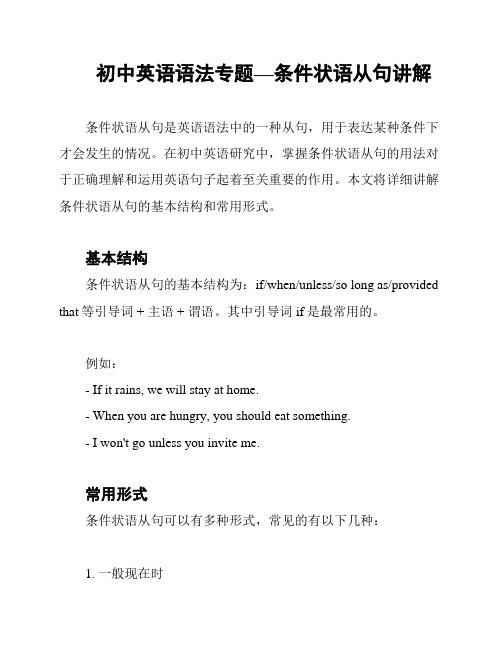
初中英语语法专题—条件状语从句讲解条件状语从句是英语语法中的一种从句,用于表达某种条件下才会发生的情况。
在初中英语研究中,掌握条件状语从句的用法对于正确理解和运用英语句子起着至关重要的作用。
本文将详细讲解条件状语从句的基本结构和常用形式。
基本结构条件状语从句的基本结构为:if/when/unless/so long as/provided that等引导词 + 主语 + 谓语。
其中引导词if是最常用的。
例如:- If it rains, we will stay at home.- When you are hungry, you should eat something.- I won't go unless you invite me.常用形式条件状语从句可以有多种形式,常见的有以下几种:1. 一般现在时如果主句是一般将来时,条件从句常用一般现在时表示将来的条件。
例如:2. 一般过去时如果主句是过去时,条件从句常用一般过去时表示过去的条件。
例如:- If it rained, we stayed at home.3. were to + V原用于表达与现在事实相反的情况,表示假设的内容。
例如:- If I were rich, I would buy a big house.4. should + V原表示建议或者要求。
例如:- If you should have any problems, feel free to ask for help.5. 省略 if在主句前可以省略if,但主句表达的语气必须是祈使句。
例如:- Study hard, and you will succeed.高级用法除了以上的基本结构和常用形式,条件状语从句还有一些高级用法需要注意。
1. 虚拟条件句表示与现在事实相反的假设情况,常用虚拟语气来表示。
例如:- If I won the lottery, I would travel around the world.2. 祈使句当主句为祈使句时,条件状语从句常用完全倒装的形式。
初中英语知识点归纳状语从句的构成及用法

初中英语知识点归纳状语从句的构成及用法归纳:状语从句作为复合句的一种,由一个从属连词引导,修饰主句中的动词、形容词或副词,起到说明、程度、时间、条件、原因等作用。
状语从句的类型包括时间状语从句、地点状语从句、条件状语从句、原因状语从句、结果状语从句等。
一、时间状语从句时间状语从句是由when, while, as, before, after, since, until, as soon as 等引导的状语从句。
1. 当时When I arrived at the park, it started to rain.当我到达公园时,天开始下雨。
2. 同时While I was studying, my phone rang.当我在学习时,电话响了。
3. 一时间As he opened the door, a gust of wind rushed in.当他打开门时,一阵风涌了进来。
4. 先后Before I leave, I will finish my homework.在我离开之前,我会完成作业。
5. 之后After she finished dinner, she went for a walk.她吃完晚饭后,去散步了。
6. 自从Since I moved to this city, I have made many new friends.自从我搬到这个城市,我交了很多新朋友。
7. 直到I will wait here until you come back.我会在这里等到你回来。
8. 一……就……As soon as the bell rang, the students rushed out of the classroom.一响铃,学生们就冲出教室。
二、地点状语从句地点状语从句是由where, wherever引导的状语从句。
1. 在……的地方I will meet you where we first met.我会在我们第一次见面的地方见你。
初三状语从句

⑤结果状语从句:
so /such ……that (如此……以至于……)
引
so (that) (因此)
导 词
so + adj /adv + that……
so + adj + a/an +可数名词单数 +that
such +a/an + adj + 可数名词单数 +that
such +adj + 可数名词复数/不可数名词 + that
happen 为非延续性动词,短动作,从 短用when
4 The boy __D___ his homework when his parents
_________ in .
A was doing were coming B did come
C did were coming
D was doing came
⑧让步状语从句:
though/although(尽管,虽然)
引
even though /if (即使)
导 词
however (然而) 疑问词 ever =no matter +疑问词
……
Although /Though he worked hard ,he failed. =He worked hard ,but he failed . Even if it rains tomorrow ,we won’t change our plan . Even though it’s hard work , I enjoy it .
①时间状语从句:
引 导
until /till (直到……) 主句谓语动词延续性动词,主句从句都用肯定式
状语从句知识点详解(初中英语专项复习)8

状语从句知识点详解(初中英语专项复习)一、分类状语从句由从属连词引导,与主句连接,位于句首时,常用逗号与主句分开,位于句末时,其前一般不用逗号。
状语从句根据其用途可分为时间状语从句、条件状语从句、原因状语从句、目的状语从句、结果状语从句、让步状语从句、比较状语从句、地点状语从句等。
状语从句的分类从句的引导词例句时间状语从句when/while/as(当……时),before(在……之前),after(在……之后),since(自从……以来),not...until(直到……才),as soon as(一……就……)I was doing my homework when myfather came in.当我爸爸进来的时候我正在做作业。
He did not go to bed until his father cameback.直到爸爸回来他才上床睡觉。
条件状语从句if(如果),as long as(只要),unless(除非)Unless bad weather stops me,I go for a walk every day.我每天都去散步,除非遇上坏天气。
原因状语从句because(因为),since(既然),as(由于)I like to eat apples because they’re good for my health.我喜欢吃苹果,因为它们对我的健康有益。
Since everyone is here,let’s begin our meeting.既然每个人都在这儿,我们开始开会吧。
目的状语从句so that(以便,为了),in orderthat(为了)He gets up early every morning so that he can get to school on time.他每天早上早起,以便能按时到校。
结果状语从句so that(结果是),so...that/such...that(如此……以至于)It’s so hot that nobody wants to go out.天太热,以至于没人想出去。
初中英语语法状语从句

初中英语语法状语从句1.时间状语从句引导连词有when,while,till,not…until,since,after ,before ,as soon asThe bus won’t start until everybody gets on.公共汽车直到每人都上车为止,才开动。
When he knocked at the door I was cooking.当他敲门时,我正在煮饭。
Last night before he came back home, his wife had already cooked dinner and waited for 2 hours.昨天晚上在他回到家之前,他的妻子已经做好晚饭足足等了他两小时之久。
After I went to church, I went shopping.2. 地点状语从句地点状语从句通常由where, wherever 引导。
Where there is a will, there is a way. 哪里有志向,哪里就有出路。
有志者事竟成。
Where there is a life, there is a hope. 哪里有生命,哪里就有希望。
留得青山在,不怕没柴烧。
Wherever you go, whatever you do, I will be right here waiting for you.不管你去哪里,不管你做什么,我都会在此守侯你。
3.原因状语从句引导连词有because,as, since。
He didn′t see the film because he had seen it.他没有看那部电影,因为他已经看过了。
They couldn’t get on the train,for it was too crowed.比较:because, since, as和for1) because语势,用来说明人所不知的原因,回答why提出的问题。
初中英语语法专题讲解--状语从句

一,状语从句状语从句在主从复合句中修饰主句中的动词、形容词或副词等,起副词的作用。
状语从句由从属连词引导,从属连词在从句中不担任任何句子成分。
状语从句可位于主句之前,也可位于主句之后。
位于主句之前,一般要加逗号与主句分开;位于句末则不需要。
状语从句根据它所表达的意思可分为时间、地点、原因、目的、结果、比较,让步、方式和条件状语从句等类。
(一),时间状语从句引导时间状语从句的从属连词有:when, while, as soon as, before, after, since , till, until 等【注】1,until (till) 直到,在用until 表达时间状语的句子中,主句中的动词是要十分小心去选择。
如动词是持续性动词,它要用肯定句,如:I studied hard until 12 o'clock last night. 如果动词是瞬间截止性动词,则要用否定句,即,not---until “直到…才”。
如:He didn't go to bed until his mother came back.They didn’t stop until they finished t he work .2,时间状语从句中的谓语动词不能用,将来时,终能用一般现在时表示一般将来时,即“主将从现”原则。
如,When he comes, I’ll tell him about it.I will call you as soon as I arrive in Beijing. 我到北京就将给你打电话(二),条件状语从句通常由从属连词if,unless等引导【注】1,条件状语从句与时间状语从句一样,从句中不能用将来时态,要用一般现在时态表示一般将来时态,也符合“主将从现”原则。
如,If it snows tomorrow, we will build a snowman.If it rains, they won't go to the park on SundayI won’t go to his party unless I am invited .,2,要区别是条件、时间状语从句还是宾语从句,因为在宾语从句中该用什么时态用什么时态,如:I want to know if he will come here tomorrowI want to know if it will rain tomorrow. If it doesn’t rain, I will go hiking.I don’t know when he will come, When he comes, I’ll tell him about it.(三),让步状语从句通常由从属连词though(although)(虽然,尽管),even if(even though)(即使)等引导注:翻译是后半句带有转折的意味,但不能由but连接。
中考状语从句知识点归纳

中考状语从句知识点归纳状语从句是英语中用来修饰动词、形容词、副词或整个句子的从句,它通常由一个引导词(如when, if, because等)引导,并在句子中承担时间、地点、原因、条件、目的、结果、让步等状语成分。
中考中,状语从句的考查是英语语法的重点之一,下面对中考状语从句的知识点进行归纳。
# 状语从句的分类1. 时间状语从句:表示动作发生的时间,常用引导词有when, while, as soon as等。
- 例如:When I arrived, he was still sleeping.2. 地点状语从句:表示动作发生的地点,常用where引导。
- 例如:Where there is a will, there is a way.3. 原因状语从句:说明发生某事的原因,常用because, since, as等引导。
- 例如:We are happy because we have achieved our goal.4. 条件状语从句:表示某事发生的条件,常用if, unless, provided that等引导。
- 例如:I will go to the party if I finish my homework.5. 目的状语从句:表示动作的目的,常用so that, in order that等引导。
- 例如:He studied hard in order that he could pass the exam.6. 结果状语从句:表示某事的结果,常用so...that, such...that 等引导。
- 例如:He was so tired that he fell asleep at his desk.7. 让步状语从句:表示尽管有某种情况,但仍然发生某事,常用though, although, even if等引导。
- 例如:Although it was raining, we still went out for a walk.# 状语从句的使用要点- 状语从句需要与主句在时态上保持一致,但有时主句使用将来时,从句使用现在时表示将来。
中考英语《状语从句》知识总结:定语从句与状语从句
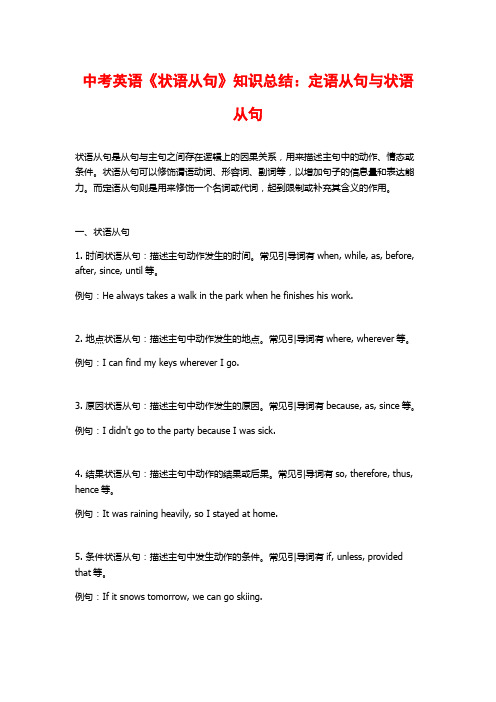
中考英语《状语从句》知识总结:定语从句与状语从句状语从句是从句与主句之间存在逻辑上的因果关系,用来描述主句中的动作、情态或条件。
状语从句可以修饰谓语动词、形容词、副词等,以增加句子的信息量和表达能力。
而定语从句则是用来修饰一个名词或代词,起到限制或补充其含义的作用。
一、状语从句1. 时间状语从句:描述主句动作发生的时间。
常见引导词有when, while, as, before, after, since, until等。
例句:He always takes a walk in the park when he finishes his work.2. 地点状语从句:描述主句中动作发生的地点。
常见引导词有where, wherever等。
例句:I can find my keys wherever I go.3. 原因状语从句:描述主句中动作发生的原因。
常见引导词有because, as, since等。
例句:I didn't go to the party because I was sick.4. 结果状语从句:描述主句中动作的结果或后果。
常见引导词有so, therefore, thus, hence等。
例句:It was raining heavily, so I stayed at home.5. 条件状语从句:描述主句中发生动作的条件。
常见引导词有if, unless, provided that等。
例句:If it snows tomorrow, we can go skiing.6. 目的状语从句:描述主句中动作的目的。
常见引导词有in order that, so that等。
例句:I'm taking extra English classes so that I can improve my speaking skills.7. 方式状语从句:描述主句中动作的方式或方法。
初中英语状语从句的使用与考点汇总
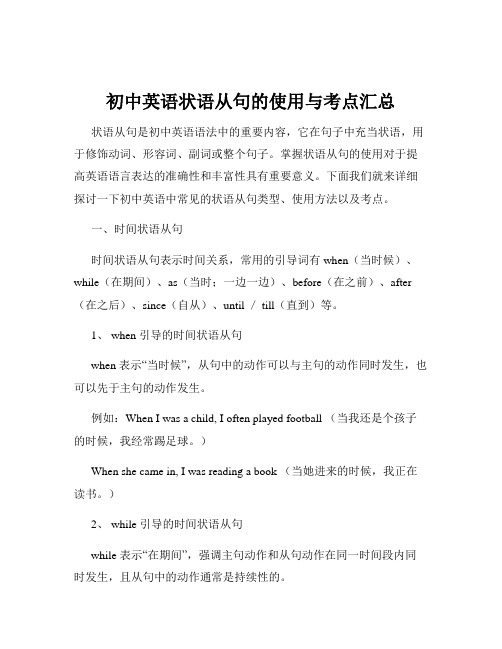
初中英语状语从句的使用与考点汇总状语从句是初中英语语法中的重要内容,它在句子中充当状语,用于修饰动词、形容词、副词或整个句子。
掌握状语从句的使用对于提高英语语言表达的准确性和丰富性具有重要意义。
下面我们就来详细探讨一下初中英语中常见的状语从句类型、使用方法以及考点。
一、时间状语从句时间状语从句表示时间关系,常用的引导词有 when(当时候)、while(在期间)、as(当时;一边一边)、before(在之前)、after (在之后)、since(自从)、until / till(直到)等。
1、 when 引导的时间状语从句when 表示“当时候”,从句中的动作可以与主句的动作同时发生,也可以先于主句的动作发生。
例如:When I was a child, I often played football (当我还是个孩子的时候,我经常踢足球。
)When she came in, I was reading a book (当她进来的时候,我正在读书。
)2、 while 引导的时间状语从句while 表示“在期间”,强调主句动作和从句动作在同一时间段内同时发生,且从句中的动作通常是持续性的。
例如:While I was doing my homework, my mother was cooking (当我在做作业的时候,我妈妈在做饭。
)3、 as 引导的时间状语从句as 表示“当时;一边一边”,强调两个动作同时发生,且动作具有延续性。
例如:As she walked along the street, she sang happily (她一边沿着街道走,一边高兴地唱歌。
)4、 before 和 after 引导的时间状语从句before 表示“在之前”,after 表示“在之后”。
例如:I had finished my homework before my father came back (我在我爸爸回来之前就完成了作业。
初中三大从句总结状语从句(时间)精讲,中考必考!

状语:状语是句子的重要修饰成分。
状语是谓语里的另一个附加成分,它附加在谓语中心语的前面,从情况,时间,处所,方式,条件,对象,肯定,否定,范围和程度等方面对谓语中心进行修饰或限制。
用来说明地点、时间、原因、目的、结果、条件、方向、程度、方式和伴随状况等。
状语一般由副词、介词短语、分词和分词短语、不定式或相当于副词的词或短语来担当。
其位置一般放在句末,但也可放在句首或句中。
副词是一种用来修饰动词,形容词,副词或全句的词,说明时间,地点,程度,方式等概念。
1.副词一般在句子中做状语.He speaks English very well.他英语说得非常好.(中的very是程度副词,用来修饰well。
very well是修饰speak的程度状语)He is playing under the tree.他在树下玩儿.(under the tree是地点状语.)2. 不定式在句子中可以作目的状语。
I come specially to see you.我专门来看你.3.介词短语Ten years ago, She began to live in Dalian.The boy was praised for his bravery.4.从句作状语When she was 12 years old, she began to live in Dalian.If I am not busy tomorrow, I will play football with you.5.分词作状语Having had a quarrel with his wife, he left home in a bad temper. Inhibited in one direction, it now seems that the Mississippi is about to take another.时间状语从句在复合句中,由时间连接词引导的状语从句叫做时间状语从句。
- 1、下载文档前请自行甄别文档内容的完整性,平台不提供额外的编辑、内容补充、找答案等附加服务。
- 2、"仅部分预览"的文档,不可在线预览部分如存在完整性等问题,可反馈申请退款(可完整预览的文档不适用该条件!)。
- 3、如文档侵犯您的权益,请联系客服反馈,我们会尽快为您处理(人工客服工作时间:9:00-18:30)。
状语从句
状语从句在复合句中作状语,修饰动词、形容词或副词等。
状语从句可以表示时间、条件、原因、地点、目的、结果、让步、方式、比较等意义。
知识梳理
时间状语从句:
Whenever he comes, he brings a friend. 他每次来都带个朋友。
条件状语从句:
As long as I am alive, I will go on studying. 只要我活着,我就要学习。
原因状语从句:
Since we live near the sea, we enjoy nice weather.由于我们住在海边,能享受到好的天气。
地点状语从句:
Put it where we can all see it.把它放在我们都能看到的位置。
目的状语从句:
Finish this so that you can start another.把这个做完,你可以开始另一个。
结果状语从句:
He was so angry that he couldn’t say a word. 他气得说不出话了。
让步状语从句:
Though he is in poor health, he works hard.虽然他身体不好,但是他工作很努力。
方式状语从句:
Students do as the teachers say.学生们按照老师说的去做。
比较状语从句:
The work isn’t as easy as I thought.这项工作比我想象得难。
例题解析
1、易混引导词while, when, as的区别:
(1)when既可以指“时间点”,与瞬间动词连用,也可以指“时间段”,与延续性动词连用(=while)。
如:
When he came in, his mother was cooking.
When (While) we were at school, we went to the library every day.
(2)While表示时间段,因此,while 从句的谓语动词要用延续性动词。
如:
Please don’t talk so loud while others are working.
(3)As与when用法相似,但着重强调主句动作与从句动作同时发生,有“随着……”或“一边……一边……”之意。
如:
As you get older, you get more knowledge.随着年龄的增长,你获得的知识就越多。
2、Because, as, since 的区别:
Because用于表示直接原因,回答why提出的问题,语气最强;As用于说明原因, 着重点在主句,常译成“由于”;since表示显然的或已知的理由或事实,常译成“既然”。
如:Water is very important because we can’t live without it.
He didn’t come yesterday as his mother was ill.
I’ll do it for you since you are busy.
3.such…that, so…that, so that 引导结果状语从句的区别:
such是形容词,修饰名词; so 是副词,修饰形容词或副词。
其结构如下:
1) such + a (n)+ 形容词+单数可数名词+that……
2) such+形容词+复数可数名词+that ……
3) such +形容词+不可数名词+that……。
如:
This was such a good film that I went to see it several times.
It was such good books that they sell well.
It was such bad weather that I had to stay at home.
He spoke so fast that I couldn’t follow him.
He is such a lovely boy that we all like him.
=He is so lovely a boy that we all like him.
注:在“形容词+可数名词复数/不可数名词”结构中,当名词前有many, much, few, little 表示数量的多少时,名词前用so。
如:
She made so many mistakes that she didn’t pass the exam.
练习与巩固
选择合适的连接词,完成下列句子。
1.Jim spends a lot of money on books ____he is not rich.
2.Kate fell into sleep ______she was listening to the music.
3.----Is David at school today?
----No. He is at home ______he has a bad cold.
4.We won’t have supper ______my mother comes back.
5.Speak to him slowly ______he may understand you better.
6. ______ she doesn’t come on Sunday, I’ll go fishing by myself.
7.It is four years ______I had left that small village.
8. ______the air moves , it is called wind.
9.We will go to the park ______it does n’t rain tomorrow.
10.______little boys did ______much work.
11.There are few new words in the passage ______we can’t understand it.
12.Go back ______you come from.
13.He reached the station ______the train had left.
14.----Do you have a swimming pool?
----No, we don’t. At least, not ______big ______yours.
15.Give me your paper ______you have finished it.
16.It is raining hard, ______we have to stay at home.
17. ______you work harder, you’ll never pass the final exam.
18.The village is ______far away ______I can’t get there on foot.
19.That is ______an interesting book ______I can’t stop reading it.
Keys: 1. though 2.while 3.because 4.until 5. so that
6.Even if
7. since
8. when
9.if 10.Such, do
11.but 12. where 13. before 14.as(so), as 15.after 16.so 17. unless 18. so, that 19.such, that。
